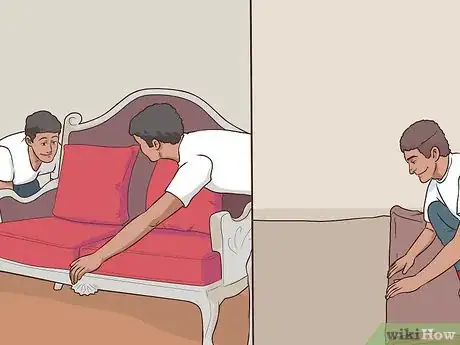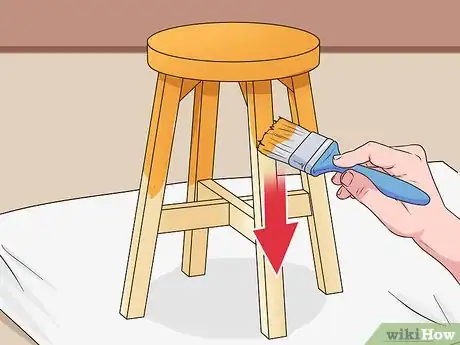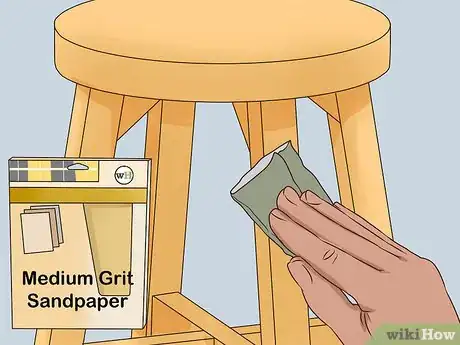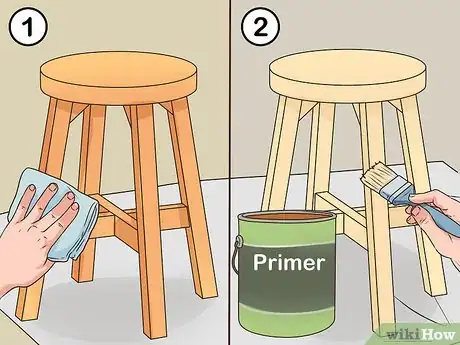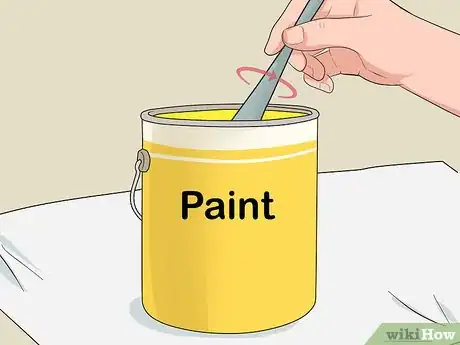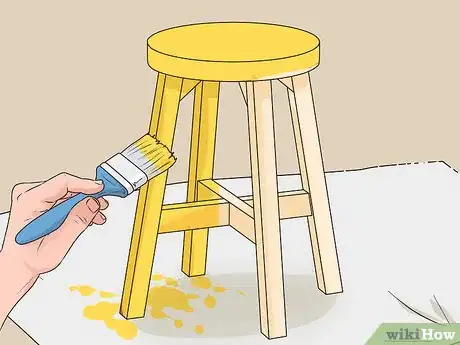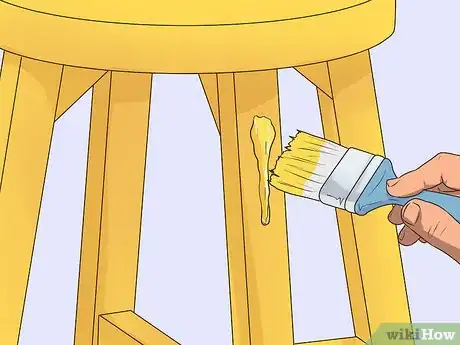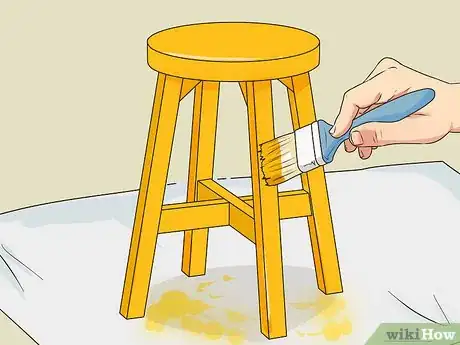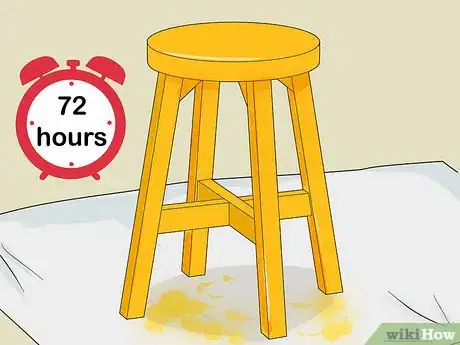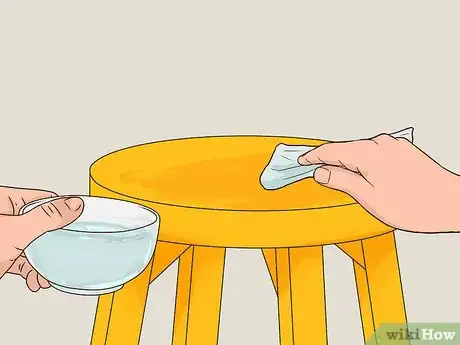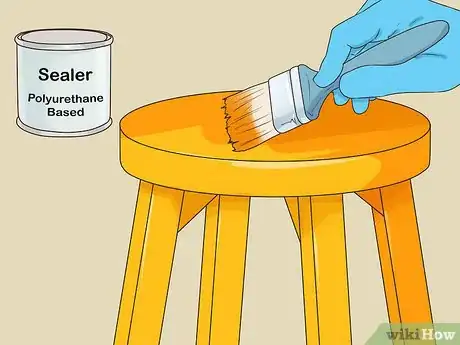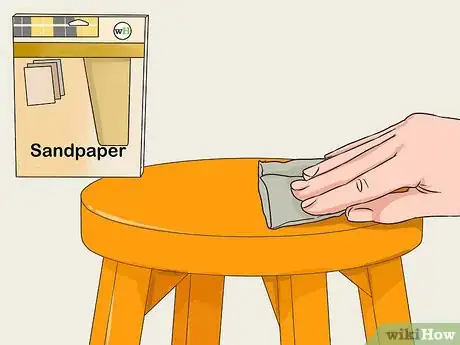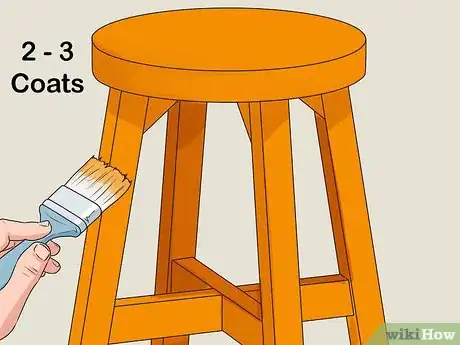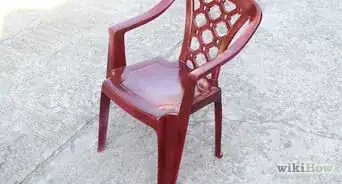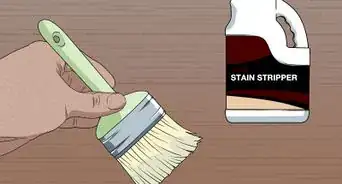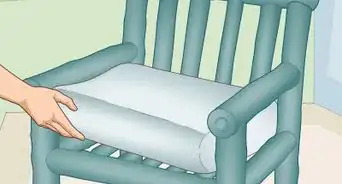This article was co-authored by Patrick Coye. Patrick Coye is the owner and operator of Patrick’s Painting & Home Improvement in Alexandria, Virginia. With over 15 years of experience in residential construction, Patrick specializes in painting, wallpaper removal/installation, drywall, staining decks and fences, and kitchen cabinetry painting. To date, Patrick and his team have painted over 2,000 houses and stained over 800 decks. Patrick's Company won a "Top Job" award from the American Painting contractor magazine in 2020.
This article has been viewed 31,756 times.
If your favorite wooden stools are looking a little worse for wear, you don't have to scrap them or call in a professional. You can easily paint stools in just one day so they look brand new. This article will walk you through the whole process step-by-step, from sanding to painting to sealing, so you can give your stools a new, beautiful finish that transforms your space.
Steps
Priming Before Painting
-
1Prepare your work area. Clear away any furniture and unnecessary equipment. Not only can these get in the way when painting, but paint could also spatter and get on surfaces you didn't intend. Furthermore, your work area should have good airflow to prevent the potential buildup of dangerous fumes.
- A drop cloth or a tarp are both great ways of preventing paint from getting on the ground, furniture, or equipment.[1]
- The entire process of priming, painting, and sealing your stool will take a few days. A work area that's out of the way, like in a shed or garage, may be most convenient.
-
2Choose a direction and stick to it. Missing an area when priming can make the end result of your paint job look unpolished or unprofessional. For this reason, you should start at one end of the stool and methodically work to the opposite end.
- Generally, you should paint from the top down to prevent the formation of drips. To get into this habit, you may also want to sand, clean, and prime from the top down, too.[2]
Advertisement -
3Sand your stool. Sanding your stool before painting will help you achieve a smooth, even finish that is more resistant to chipping.[3] A thorough hand sanding should be sufficient in most cases, though you might find an orbital sander speeds up this process. When sanding:
- Wear a dust mask to prevent lung irritation or damage from accidentally breathing in dust produced while sanding.
- Use a medium grit (60 - 100 rating) sandpaper.[4] Sand with medium pressure and overlapping strokes to prevent yourself from missing spots.
- Target bumps, loose paint, and uneven surfaces when sanding. Sand until the entire surface is even and smooth.[5]
- Even if the primer, paint, and sealer you've chosen for this job claims no sanding is necessary, sanding will always improve the end result.[6]
-
4Clean your stool and apply primer to it.[7] Sanding will usually create a fine film of dust on the surface of your stool. This can cause clumping or create unevenness in your primer coat. Dampen a clean cloth, and wipe all surfaces of the stool thoroughly. Then:
- Allow the surface of the stool to dry completely before priming. You can speed the this process by following the damp cloth wipe with a clean, dry cloth wipe.
- Mix your primer thoroughly, then dip your brush in it. Wipe excess primer on the inner lip of its can, then apply the primer to your entire stool in a thin coat.
- Follow your primer's label instructions for the best results, but generally, after ten minutes your stool should be ready for another coat.
- Typically, multiple thin coats are better than a single thick one. You may even be able to see the grain of your wood through the primer. Don't worry, this is natural.[8]
Painting Your Stool
-
1Mix your paint. Open your paint and use a paint stirrer to thoroughly mix the contents of the can. Not mixing most kinds paint can cause its components to separate, resulting in a less than ideal finished product.
- Some paint or hardware stores may offer to mix your paint in an automatic mixer. These can significantly speed the mixing process.[9]
-
2Paint the stool. Take a clean paintbrush and dip it into the paint. Wipe excess paint on the inside lip of the can and apply the paint in long, thin, overlapping strokes. Remember to paint from the top down, as this will help prevent the formation of drips in the paint.
- Wait until the paint dries before adding another coat. Some quick drying paints may be ready for a second coat in as few as 10 minutes. Check your paint label to confirm your paint's dry time.
- Very humid conditions can lengthen the amount of time it takes your paint to dry. If you live in a humid climate, touch test your paint at the end of its dry time to verify it's actually dry.[10]
-
3Touch up drips and drizzles. After you've finished each coat of paint, step back from the stool and check all its surfaces for drips or unevenness. Use your paintbrush to touch up these areas, smoothing the paint until it is consistent on all surfaces.
- Corners, edges, and downward oriented parts of the stool tend to collect paint and are frequent drip zones.
-
4Add more coats of paint to your stool. Paint in the same fashion as previously described when adding a new coat. For simple or rustic projects, two coats may be enough, though ordinarily, multiple thin coats of paint are better than a single thick coat.
- If you have time, aim for five thin coats of paint. This will ensure a better appearance and a more durable paint job.[11]
Sealing the Paint
-
1Wait for paint to cure before sealing it. In most cases, your paint will need at least four days before it has cured to the point that sealer can be applied. Some paints, however, might require up to seven days before they are sealer ready.
- At minimum, you should wait at least 72 hours for the paint to dry before applying sealer to the stool.[12]
-
2Clean the surfaces of your painted stool. If your stool has been recently painted, it's not likely it'll need a thorough cleaning, but even a near invisible coat of dust can negatively impact your sealing. Dampen a clean rag with water and then wipe all surfaces you intend to seal.[13]
- After wiping with a damp rag, you'll have to wait until the stool is dry again before applying sealer. In many cases, 10 minutes should be enough.
- You can speed the drying process by wiping residual moisture on the surfaces of your stool with a dry rag.
-
3Apply sealer to your paint. Many sealers are polyurethane based, which can be difficult to remove from your hands. Wear rubber gloves and long sleeves for protection.[14] Take a clean paintbrush and dip it into your sealer, then:
- Wipe your brush on the inner lip of the can to remove excess sealer from the brush. Generally, your sealer should be applied in thin coats.
- Use long strokes that overlap when painting on your sealer to get the most consistent and complete coat.[15]
-
4Sand your stool after the sealer dries. Different sealers will require you to wait different lengths of time before they are ready to be sanded. Check the label instructions that came with your sealer to determine the wait time for your primer. Then:
- Use a fine grit sandpaper that has a grit rating of at least 220 to lightly sand all sealed surfaces.
- After sanding, dampen a clean cloth and wipe away any dust that has formed. Then wait until the surface is totally dry before adding more coats.[16]
-
5Seal with additional coats. In most cases, your sealer will be most effective with at least two coats, though you may find three works even better. In the fashion previously described, apply your sealer to the stool until you are satisfied with the result.[17]
Expert Q&A
-
QuestionWhat should I keep in mind when painting an oak stool?
 Patrick CoyePatrick Coye is the owner and operator of Patrick’s Painting & Home Improvement in Alexandria, Virginia. With over 15 years of experience in residential construction, Patrick specializes in painting, wallpaper removal/installation, drywall, staining decks and fences, and kitchen cabinetry painting. To date, Patrick and his team have painted over 2,000 houses and stained over 800 decks. Patrick's Company won a "Top Job" award from the American Painting contractor magazine in 2020.
Patrick CoyePatrick Coye is the owner and operator of Patrick’s Painting & Home Improvement in Alexandria, Virginia. With over 15 years of experience in residential construction, Patrick specializes in painting, wallpaper removal/installation, drywall, staining decks and fences, and kitchen cabinetry painting. To date, Patrick and his team have painted over 2,000 houses and stained over 800 decks. Patrick's Company won a "Top Job" award from the American Painting contractor magazine in 2020.
Painting Specialist The biggest mistake is not using high quality primer. You want a stain blocking primer, something that's going to resist any stains coming through on the finish coat.
The biggest mistake is not using high quality primer. You want a stain blocking primer, something that's going to resist any stains coming through on the finish coat. -
QuestionDo you need to remove the old finish completely?
 Community AnswerYou may want to try your best to remove all of what is left from the previous finish before painting or else the paint won't fix. Small parts of sanded over old finish are fine though; remove as much as you can, then sand over as much as possible and it'll be ready to paint.
Community AnswerYou may want to try your best to remove all of what is left from the previous finish before painting or else the paint won't fix. Small parts of sanded over old finish are fine though; remove as much as you can, then sand over as much as possible and it'll be ready to paint.
Warnings
- Some primers, paints, or sealers, may not work together. Check the label of potential primers, paints, and sealers to ensure these products work together.⧼thumbs_response⧽
- Toxic fumes from your primer, paint, or sealer can build up in poorly ventilated spaces and cause injury or death. Always paint in areas with good airflow.⧼thumbs_response⧽
Things You'll Need
- Clean rag (x2)
- Dust mask
- Paint
- Paint stirrer
- Paintbrush (x3)
- Primer
- Rubber gloves
- Sandpaper (fine grit; 220+ rating)
- Sandpaper (medium grit; 60 to 100 rating)
- Sealer
References
- ↑ Patrick Coye. Painting Specialist. Expert Interview. 22 July 2020.
- ↑ http://www.bobvila.com/articles/30124-dream-it-do-it-how-to-paint-wood-furniture/#.V_BITlQrLIV
- ↑ Patrick Coye. Painting Specialist. Expert Interview. 22 July 2020.
- ↑ http://www.bobvila.com/articles/2145-quick-tip-choosing-sandpaper/#.V_BKq1QrLIV
- ↑ https://www.thisoldhouse.com/how-to/how-to-paint-room
- ↑ http://www.countryliving.com/diy-crafts/tips/a266/paint-furnishings-and-learn-from-my-mistakes/
- ↑ Patrick Coye. Painting Specialist. Expert Interview. 22 July 2020.
- ↑ http://www.bobvila.com/articles/30124-dream-it-do-it-how-to-paint-wood-furniture/#.V_BITlQrLIV
- ↑ http://www.bobvila.com/articles/30124-dream-it-do-it-how-to-paint-wood-furniture/#.V_BITlQrLIV
- ↑ http://www.bobvila.com/articles/30124-dream-it-do-it-how-to-paint-wood-furniture/#.V_BITlQrLIV
- ↑ http://www.bobvila.com/articles/30124-dream-it-do-it-how-to-paint-wood-furniture/#.V_BITlQrLIV
- ↑ http://www.countryliving.com/diy-crafts/tips/a266/paint-furnishings-and-learn-from-my-mistakes/
- ↑ http://www.countryliving.com/diy-crafts/tips/a266/paint-furnishings-and-learn-from-my-mistakes/
- ↑ Patrick Coye. Painting Specialist. Expert Interview. 22 July 2020.
- ↑ http://www.allthingsthrifty.com/2012/09/how-to-seal-your-furniture-and-when-it.html
- ↑ http://www.allthingsthrifty.com/2012/09/how-to-seal-your-furniture-and-when-it.html
- ↑ http://www.allthingsthrifty.com/2012/09/how-to-seal-your-furniture-and-when-it.html
